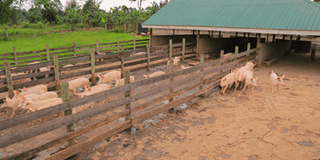Breeding piglets for real wealth

Pigs rush for routine fresh air after being released by the farm manager. Photos by EDGAR BATTE
What you need to know:
- Israel Serunjogi owns Buwanuka Green Farm, in Gayaza, Wakiso District. It is here that several prospective farmers buy their piglets, writes, EDGAR R. BATTE.
Observation and optimism were two reasons that drove Israel Serunjogi to venture into farming.
He had been observing his elder brother, Enock Mukiibi tend to a small-scale pig farm at home.
As Mukiibi set up his piggery, Serunjogi was finalising his studies at Makerere University Business School (MUBS) where he pursued a diploma in accounting and finance. This was in 2006.
Man on mission
“I learned that pigs multiply very fast and the demand for pork was high. I had a meeting with my parents and siblings and told them about the possibility of us doing a piggery project, on a large scale,” he recalls.
When they agreed, Serunjogi’s next step was to start visiting farms in Kampala and Wakiso districts to get ideas and familiarise with piggery enterprises.
He visited Bruno Matovu’s piggery project in Nakasongola, Gen. Katumba Wamala’s in Mukono, Kampala Capital City Authority (KCCA) demonstration farm in Kyanja and Makerere University agricultural research institute in Kabanyolo.
This helped him learn about different types of breeds, type of structures to construct, what and how much to feed pigs, biosecurity, sanitation and record keeping.
He knew that his knowledge in accounting and finance would be of use in particularly keeping tabs on the financial investment when he set up Buwanuka Green Farm in Gayaza, Wakiso District.
Starting
Four years down the road, Serunjogi with a family loan of Shs30m was ready to kick-start the project.
He set up the pig pen, partitioning it to accommodate more than 200 pigs.
His parents already had the land. The money was to develop the land for piggery.
Breeding
The business model he wanted to realise was to sell piglets to existing farmers who want to introduce a new breed to their farm or those who are starting out into piggery.
“I knew breeding is viable because I would not have to spend a lot on feeds since the piglets are sold at two months. Right now I am able to sell pregnant sows and ready-to-service boars too,” he explains.
At the moment, he has parent stock (female) of 25 pigs. Each pig will farrow (produce) twice a year an average of 12 piglets. After eight weeks, Serunjogi sells each piglet between Shs100,000 and Shs150,000 depending on the type.
Marketing
He markets the piglets through social media; Facebook and farmers’ WhatsApp groups.
Lessons
He explains, “I have learned that you reap what you sow. There are no shortcuts. Piggery has also taught me how to be patient and plan well because there are so many dynamics that you have to learn on the job; things like employees leaving without notice. I have also learned how to do work myself, and learn a thing or two from other farmers who visit my farm.”
Feeds
He adds, “I have to make sure that feeds are available especially when the cost of maize bran goes up. I have planted seven acres of sweet potatoes. The sweet potato vines are nutritious to pigs and also help to cut on costs. I mix the feed and clean the stys and use the manure in my garden. I also sell it to others.” He spends Shs600, 000 every month on buying feeds such as maize bran.
Treatment
He keeps tabs on market trends, like new drugs in the market that are used for treatment of the pigs. He initially used to treat them using disinfectant such as nonocleanse, from Norbrook. A farmer friend advised Serunjogi to use BioSafe, which is cheaper.
Records
To manage finances, Serunjogi keeps records; every expense and revenue are recorded in the books. At the end of every quarter, the farmer plans how to boost profits by cost cutting without affecting the output and quality of stock.
Expenses
His constant expenses include salaries on which he spends Shs300, 000.
He employs six people. He spends Shs120, 000 on dewormers, multivitamins and iron for every two months. He earns about Shs9m every three months.
Cleaning
“When cleaning, water must not stay stagnant. It should flow to the drainage. This reduces on spread of diseases and infections and also eliminates the bad smell,” he observes.
He checks on the pigs twice a day to see if they are healthy and have eaten the food.




